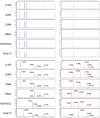Rapid detection and strain typing of Chlamydia trachomatis using a highly multiplexed microfluidic PCR assay
- PMID: 28562672
- PMCID: PMC5451082
- DOI: 10.1371/journal.pone.0178653
Rapid detection and strain typing of Chlamydia trachomatis using a highly multiplexed microfluidic PCR assay
Abstract
Nucleic acid amplification tests (NAATs) are recommended by the CDC for detection of Chlamydia trachomatis (Ct) urogenital infections. Current commercial NAATs require technical expertise and sophisticated laboratory infrastructure, are time-consuming and expensive, and do not differentiate the lymphogranuloma venereum (LGV) strains that require a longer duration of treatment than non-LGV strains. The multiplexed microfluidic PCR-based assay presented in this work simultaneously interrogates 13 loci to detect Ct and identify LGV and non-LGV strain-types. Based on amplified fragment length polymorphisms, the assay differentiates LGV, ocular, urogenital, and proctocolitis clades, and also serovars L1, L2, and L3 within the LGV group. The assay was evaluated in a blinded fashion using 95 clinical swabs, with 76 previously reported as urogenital Ct-positive samples and typed by ompA genotyping and/or Multi-Locus Sequence Typing. Results of the 13-plex assay showed that 51 samples fell within urogenital clade 2 or 4, 24 samples showed both clade 2 and 4 signatures, indicating possible mixed infection, gene rearrangement, or inter-clade recombination, and one sample was a noninvasive trachoma biovar (either a clade 3 or 4). The remaining 19 blinded samples were correctly identified as LGV clade 1 (3), ocular clade 3 (4), or as negatives (12). To date, no NAAT assay can provide a point-of-care applicable turnaround time for Ct detection while identifying clinically significant Ct strain types to inform appropriate treatment. Coupled with rapid DNA processing of clinical swabs (approximately 60 minutes from swab-in to result-out), the assay has significant potential as a rapid POC diagnostic for Ct infections.
Conflict of interest statement
Figures


References
-
- Newman L, Rowley J, Vander Hoorn S, Wijesooriya NS, Unemo M, Low N, et al. Global estimates of the prevalence and incidence of four curable sexually transmitted infections in 2012 based on systematic review and global reporting. PloS one. 2015;10(12):e0143304 10.1371/journal.pone.0143304 - DOI - PMC - PubMed
-
- Mårdh P-A. Tubal factor infertility, with special regard to chlamydial salpingitis. Current opinion in infectious diseases. 2004;17(1):49–52. - PubMed
-
- Dean D. Pathogenesis of Chlamydial Ocular Infections In: Duane’s Foundations of Clinical Ophthalmology. Tasman W, Jaeger EA, eds. Lippincott Williams & Wilkins; 2. Philadelphia, PA: 2010. p. 678–702.
-
- Martin-Iguacel R, Llibre J, Nielsen H, Heras E, Matas L, Lugo R, et al. Lymphogranuloma venereum proctocolitis: a silent endemic disease in men who have sex with men in industrialised countries. European journal of clinical microbiology & infectious diseases. 2010;29(8):917–25. - PubMed
MeSH terms
Grants and funding
LinkOut - more resources
Full Text Sources
Other Literature Sources

